TRADE&TASTE
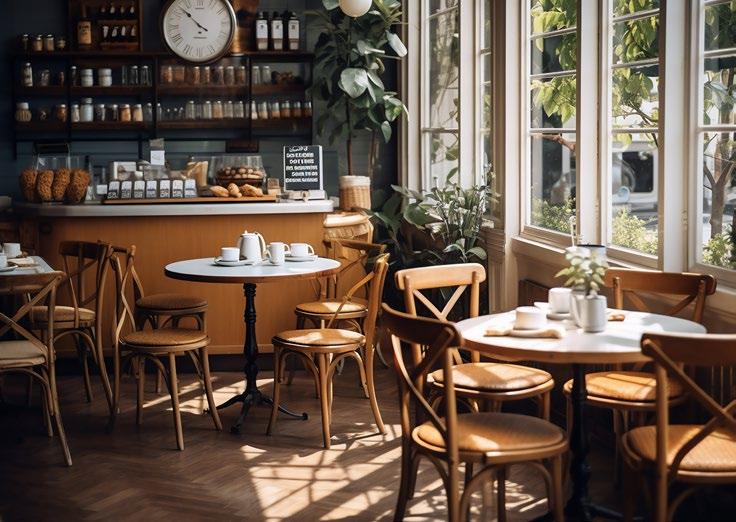
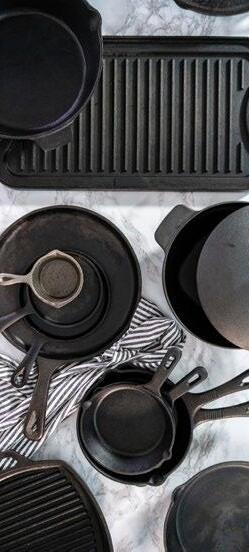
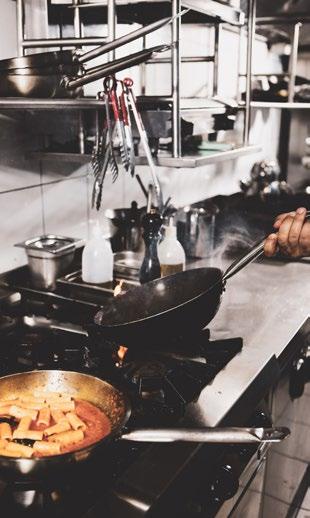
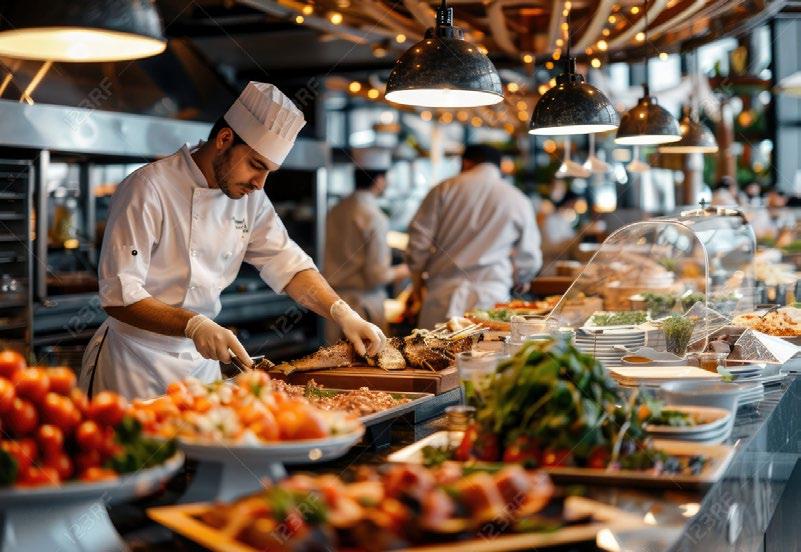
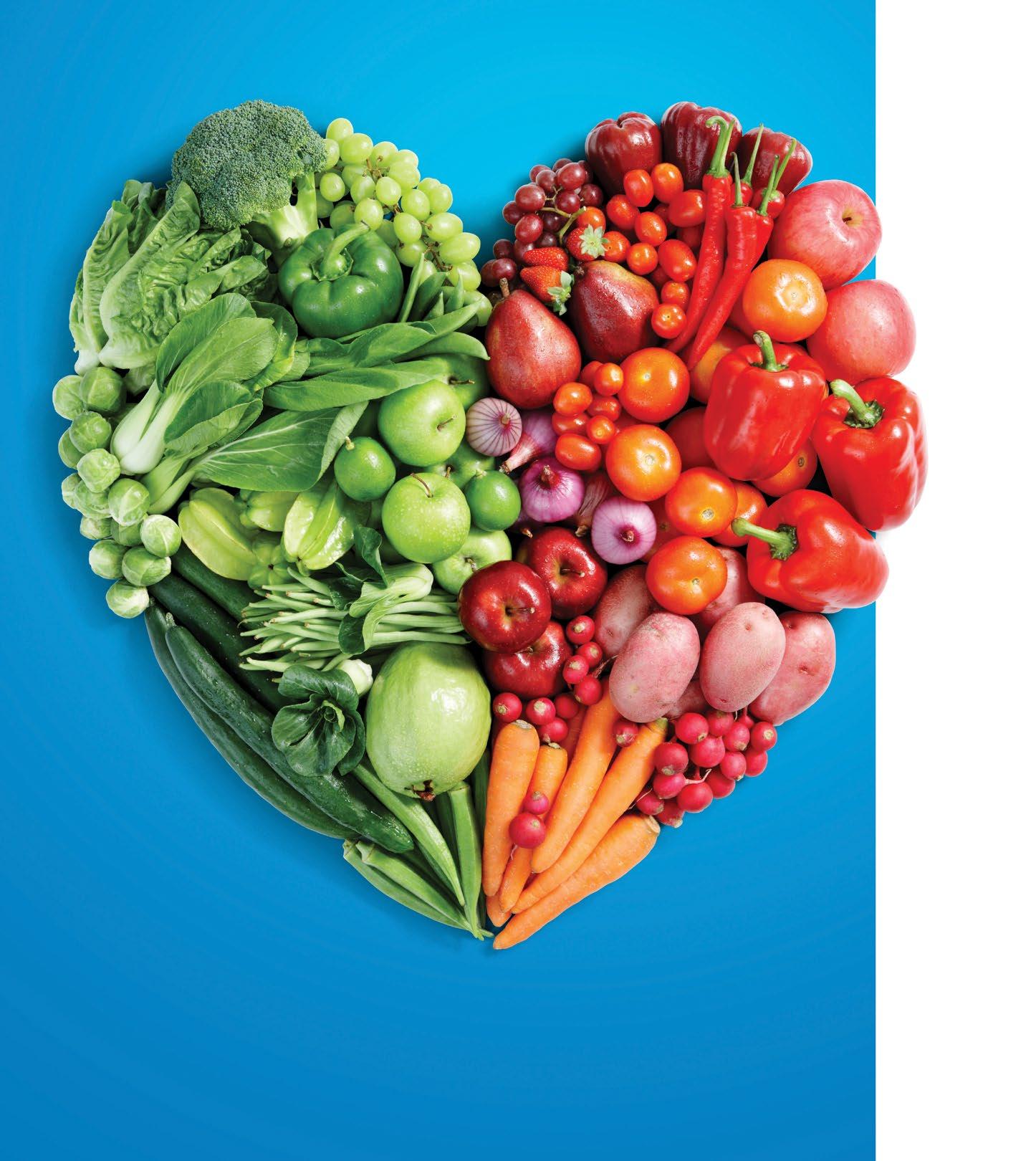

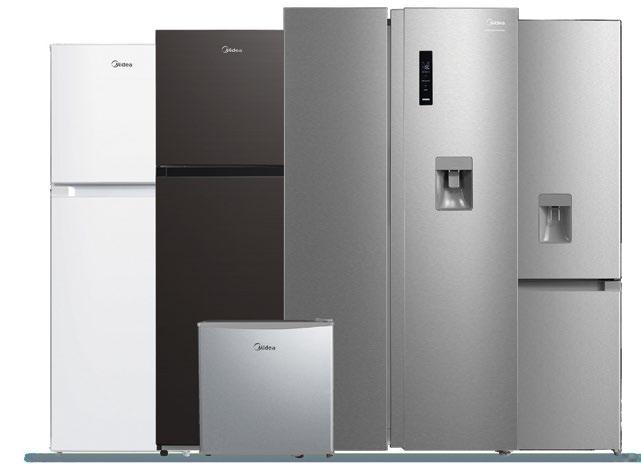









Welcome to the debut edition of Trade and Taste — a publication born out of a deep respect for the hospitality and food services industry, and the remarkable people who power it.
For years, we’ve had the privilege of connecting with chefs, restaurateurs, hoteliers, producers, suppliers, and service providers through Essential Flavours — a magazine that has celebrated culinary creativity and quality. But we knew there was more to uncover. The business of hospitality isn’t just about the plate or the guest room; it’s about the supply chains, the training, the technology, the resilience, and the partnerships behind the scenes.
Trade and Taste is our response to that gap — a curated, annual deep-dive into the trends, tools, and talents shaping hospitality in South Africa and beyond. Whether you run a boutique hotel, manage a multi-site restaurant group, or supply the ingredients and innovations that keep the industry moving, this magazine is designed with you in mind.
Inside these pages, you’ll find market insights, product spotlights, thought leadership, and success stories that showcase the spirit of trade — and the importance of taste — in every form. This is more than a magazine; it’s a resource, a connection hub, and a celebration of excellence in an ever-evolving sector.
Thank you to our advertisers, contributors, and the passionate professionals who make this industry thrive. We hope Trade and Taste finds a proud place on your desk — not just for inspiration, but for real, practical value.
Here’s to a future of bold partnerships, better service, and brilliant taste. Enjoy the read.
Elroy van Heerden Mays Editor-in-Chief Trade and Taste Magazine


06 Hospitality Forecast 2026: What’s Shaping the Year Ahead
07 The Rise of Experiential Dining: Creating Moments, Not Just Meals
10 Smart Kitchens: The Future of Automated Culinary Spaces
15 Sustainability That Sells: How Eco Choices Are Influencing Bookings
18 From Menu to Market: The Plant-Based Evolution in SA
21 Loadshedding-Proof Operations: Survival Tools for Hospitality
22 Tapping into Township Tourism: Untapped Potential for Growth
25 Post-Pandemic Service Models: What Stays, What Goes

28 Trending Flavours in 2026: Local is the New Global 30 Inside the Cellar: South African Wine Trends to Watch 34 Crafting the Perfect Mocktail Menu
36 The Chef’s Table: 5 Top Chefs Share Their Menu Development Process
39 Butchery to Table: Reclaiming the Art of Whole Cuts 41 Coffee Culture: A Roaster’s Guide to Building a Better Brew
Cooking with AI: Will Tech Ever Replace the Taste of Experience?
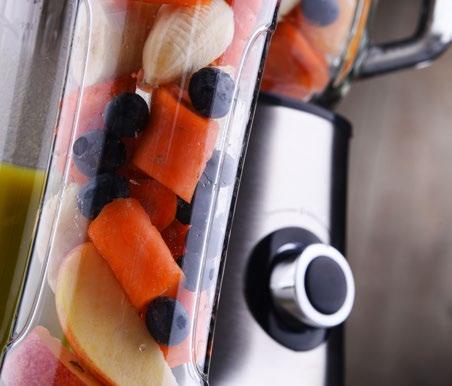
48 Managing Rising Food Costs: Smart Strategies for 2026
50 The Art of Upskilling: Hospitality Staff Training That Works
53 Digital Bookings: Best Practice for Better Conversion
56 Front-of-House Etiquette: What’s Expected in Modern Service
58 Costing vs Quality: Finding the Sweet Spot in Procurement
62 How to Build a Resilient Hospitality Team
63 Rethinking Room Service: Modernising the Guest Experience

Top 10 Game-Changing Kitchen Tools for 2026
Inside the Cold Chain: Why Refrigeration Matters More Than Ever
The Great Gear Guide: Supplier Innovations You Shouldn’t Miss
Ethical Sourcing: Who’s Leading in Traceable Supply? 75 Spotlight: Local Equipment Brands Making Global Moves
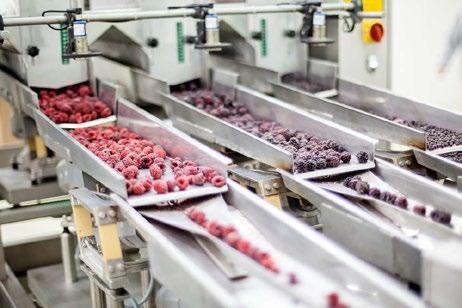

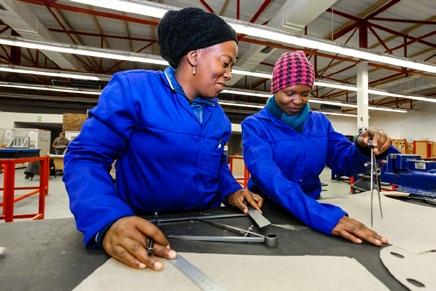


FoodBev




76 Building a Hospitality Brand in a Crowded Market
79 Social Media Playbook: 10 Campaign Ideas That Actually Work
82 Loyalty Programs That Drive Real Retention
84 Food Influencers: Collaborate or Compete?
87 Maximising Online Reviews: Turning Feedback into Fuel

106 The Psychology of Restaurant Interiors
108 Wellness Hospitality: Spas, Sleep, and Superfoods
112 Signature Touches: What Makes a Guest Keep Coming Back

90 Women Leading the Way in Hospitality
92 Meet the Supplier: Conversations with South Africa’s Top Producers
95 Hospitality Legends: Stories Behind Iconic SA Restaurants
97 Young Guns: Rising Stars Under 30 to Watch
99 The Hotelier Diaries: A Day in the Life of a General Manager
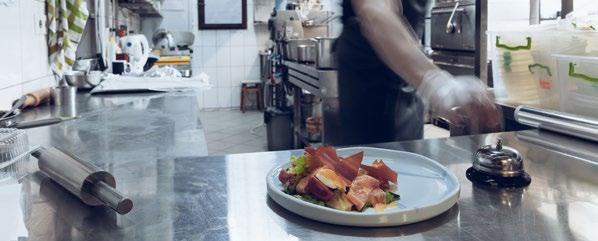
EDITORIAL: editor@tradeandtaste.co.za • ADVERTISING: publisher@tradeandtaste.co.za
TEL: +27 (0)21 424 3625 l www.tradeandtaste.co.za
DESIGN & LAYOUT
EDITOR-IN-CHIEF
Elroy van Heerden-Mays
SUB-EDITOR: Kim Kay
CONTENT COORDINATOR:
Wadoeda Adams / Ketsia Makola
PROOFREADER: Maurisha Niewenhuys
ADVERTISING SALES:
Maxine Arries
Fiona Myburg
Boniswa Tshiqi Dumisani Mbatshu
Shaun van Heerden-Mays / Anja Bramley Tia Arendse
DIGITAL AND SOCIAL MEDIA
Juhi Rampersad / Kyla van Heerden
WEB DEVELOPER: Richard van Staden
ACCOUNTS: Maurisha Niewenhuys
DISTRIBUTION: Shihaam Gyer On The Dot - Retail Media Support - Industry Professionals
PICTURE CREDIT: 123RF







THE HOSPITALITY AND FOOD SERVICES INDUSTRY HAS ALWAYS BEEN DEFINED BY RESILIENCE, REINVENTION, AND RELATIONSHIPS — AND 2026 IS NO DIFFERENT. AS WE STEP INTO A NEW CHAPTER SHAPED BY SHIFTING GLOBAL DYNAMICS, LOCAL REALITIES, AND TECHNOLOGICAL ADVANCEMENTS, IT’S CLEAR: SUCCESS THIS YEAR WILL BELONG TO THE BOLD, THE AGILE, AND THE DEEPLY CONNECTED.
Here’s what industry professionals should have on their radar in the year ahead.
1ELEVATED LOCALISM: THE POWER OF PROUDLY SOUTH AFRICAN
While international travel is back in full swing, 2026 will be the year of celebrating local — not just in ingredients but in experience, culture, and community. From township tours to farm-to-fork tasting menus, guests are seeking deeper connection to place and authenticity. Hospitality brands that build strong regional narratives will thrive. This means showcasing indigenous ingredients, local art, rural wine routes, and even traditional music or storytelling as part of the guest experience.
2THE GREEN MANDATE: SUSTAINABILITY MOVES FROM TREND TO STANDARD
Sustainability is no longer a “nice to have” — it’s expected. Water-saving technologies, zero-waste kitchens, solarpowered lodges, and plastic-free alternatives will become industry standards. Properties that fail to comply or communicate their environmental commitments risk losing conscious consumers — especially Gen Z and Millennial travellers who are voting with their wallets.
Brands embracing the circular economy, eco-certifications, and farm partnerships will have an edge, especially as carbon transparency begins to influence booking platforms and corporate contracts.

3
TECH-DRIVEN TOUCHPOINTS: FROM GUEST APPS TO AI CHEFS
Digital innovation will continue to transform hospitality in 2026 — but not at the cost of human connection. Mobile checkins, app-based ordering, AI chatbots, and smartroom controls are now expected in mid-to-premium establishments. But the real shift lies in predictive guest service: systems that anticipate needs before they arise.
AI is also moving into kitchens. While it won’t replace chefs, it’s playing an increasing role in menu planning, stock forecasting, and allergen tracking — making operations leaner, smarter, and more responsive.
Recruitment and retention continue to challenge the industry — especially in frontof-house roles and technical kitchens. In 2026, the winners will be those who invest in training, offer purpose-driven workplaces, and actively build their employer brand.
Micro-credentials, mentorship programs, and hybrid roles are becoming the norm. Younger employees are looking for flexible hours, clear career paths, and a sense of belonging. Offering those things isn’t just nice — it’s necessary.
5WELLNESS-DRIVEN HOSPITALITY: REST, RESTORE, RECHARGE
Wellness is no longer confined to spa resorts. It’s influencing menu choices, room design, and service philosophies across the board. Think sleepfocused packages, functional beverages, outdoor yoga on rooftops, air purification systems, and menus built around gut health or hormone balance.
Hospitality spaces that nurture body and mind will appeal not only to tourists, but to overworked locals seeking micro-retreats and meaningful rest.
6DYNAMIC PRICING AND SMARTER REVENUE MANAGEMENT
With economic pressure mounting, from load shedding to inflation, establishments must get smarter about yield. Dynamic pricing models — already standard in aviation
and car rentals — are becoming vital for hotels, event venues, and even restaurants.
Revenue management tools that adjust pricing based on demand, competitor behaviour, and calendar events will help maximise margins without compromising guest value.
7EXPERIENCE IS EVERYTHING
Lastly, it’s important to remember: guests are no longer just buying beds or meals — they’re buying moments. Story-driven stays, interactive chef tables, handson cultural workshops, and destination-based dining will set leading brands apart. People remember how you made them feel. In 2026, that emotional connection will be the true currency of hospitality.

ADAPT OR BE LEFT BEHIND
The hospitality landscape in 2026 is both exciting and demanding. It calls for courage, creativity, and collaboration across the board — from chefs and GMs to suppliers and marketers. While challenges persist, so do opportunities.
At Trade and Taste, we believe that those who lean into innovation, honour their heritage, and stay customerobsessed will not only survive — but set the standard for the years ahead. TT

WALK INTO A CUTTING-EDGE RESTAURANT KITCHEN IN 2026, AND YOU’LL NOTICE SOMETHING SUBTLE — IT HUMS, CALCULATES, CALIBRATES, AND EVEN THINKS. NO, THE CHEFS HAVEN’T BEEN REPLACED. BUT THEY’RE NOW ASSISTED BY AN INTELLIGENT ECOSYSTEM OF CONNECTED DEVICES, DATA-POWERED APPLIANCES, AND AI-DRIVEN SYSTEMS TRANSFORMING HOW PROFESSIONAL KITCHENS OPERATE.
Welcome to the world of smart kitchens, where automation isn’t about removing the human touch — it’s about refining it.
WHAT EXACTLY IS A SMART KITCHEN?
A smart kitchen is more than just a space with high-tech gadgets. It’s an interconnected environment where
appliances, software, and sensors communicate with each other — and with the chefs — to streamline workflow, reduce waste, optimise inventory, and improve consistency.
From ovens that adjust temperature based on humidity to AI platforms that suggest recipes based on leftover stock, smart kitchens are turning culinary creativity into an efficient science.
THE RISE OF CULINARY
In the hospitality industry, time and precision are money. Smart kitchen tech helps deliver both.
• AI-Enhanced Prep: Robotic arms are now assisting with chopping, portioning, and plating in high-volume kitchens. These systems reduce human error and accelerate production without compromising hygiene.
• Programmable Cooking Equipment: Ovens, grills, and
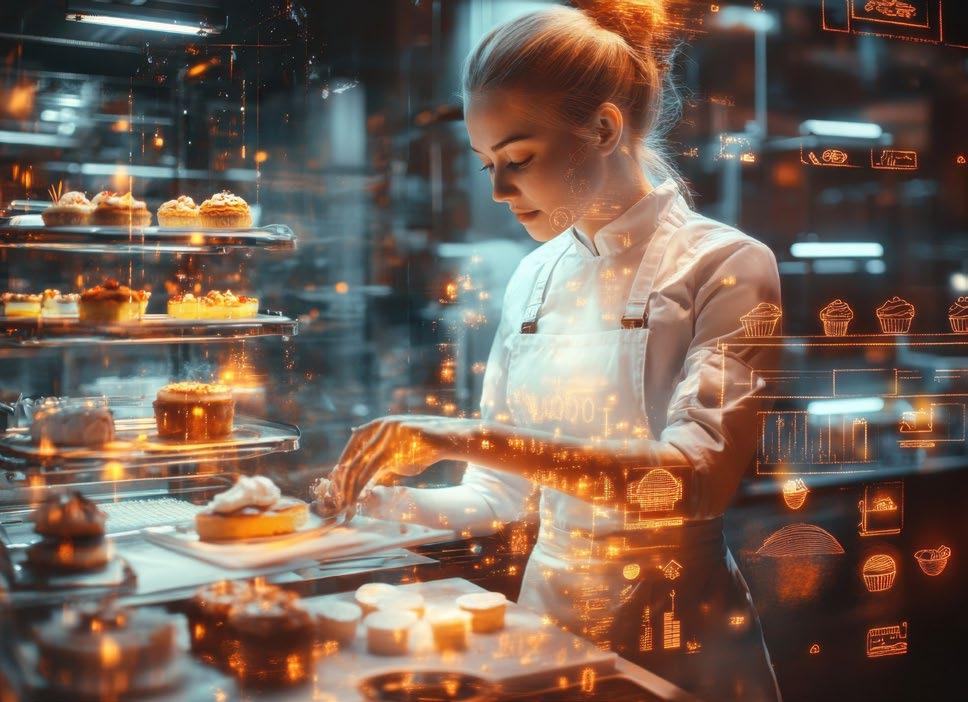
• steamers now come with pre-set recipes, automated timers, and real-time sensors that ensure consistent results every single time — critical in franchise or multi-site operations.
• Integrated Ordering Systems: POS systems now link directly to kitchen display systems (KDS), alerting prep stations based on dish complexity and wait times, not just order sequence. This makes rush hours far more manageable.
One of the smartest upgrades in today’s culinary spaces lies in the back of house. Smart fridges, scales, and software can now:
• Monitor stock levels in real time
• Alert chefs when ingredients are about to expire
• Automatically reorder from suppliers when inventory hits
minimum thresholds
• Track which ingredients are underor over-utilised to reduce wastage
This doesn’t just save money — it supports sustainability, something increasingly valued by both regulators and guests.
Kitchens today generate data — and the smart ones know how to use it.
By tracking sales, prep times, and ingredient usage, smart systems can:
• Identify bestselling dishes and topperforming service times
• Highlight inefficiencies in workflow
• Help chefs plan menus based on seasonal demand, pricing trends, or health requirements
This kind of insight empowers hospitality operators to fine-tune
Automation tech can be pricey, but with energy savings, waste reduction, and improved output, the return on investment is proving worthwhile over time.

offerings and reduce overheads without losing flavour or flair.
1. Consistency Across Locations
For restaurant groups or hotels with multiple kitchens, smart tech ensures that a dish in Cape Town tastes the same as it does in Durban.
2. Improved Training & Onboarding
New staff can be brought up to speed quicker, with visual recipe guides, automation-assisted cooking processes, and real-time support.
3. Enhanced Food Safety
Temperature-monitoring systems and hygiene alerts are now standard features in high-end smart kitchens, helping brands stay compliant and confident.
Despite the benefits, smart kitchen adoption isn’t without its challenges in the South African market:
• High Upfront Costs: Automation tech can be pricey, but with energy savings, waste reduction, and improved output, the return on investment is proving worthwhile over time.
• Connectivity Issues: Load shedding and inconsistent internet access remain hurdles. However, manufacturers are responding with offline modes, battery backups, and data syncing that mitigates interruptions.
• Workforce Resistance: Some fear that automation will replace jobs. In reality, smart kitchens enhance roles — allowing chefs to focus on innovation and quality rather than repetitive tasks.
It’s important to remember: technology doesn’t replace creativity, intuition, or heart. It simply amplifies them. A perfectly timed steak is impressive — but it’s the hospitality behind the plate that leaves a lasting impression.
The most successful kitchens of 2026 will find a balance between automation and authenticity. They’ll use tech not to remove people from the process, but to empower them with better tools, sharper insight, and more room to delight.
From small boutique hotels to global franchise kitchens, smart culinary spaces are redefining the hospitality experience. In an industry built on speed, skill, and service, automation is no longer optional — it’s strategic.
Invest in your kitchen, and you’re investing in your brand. The future is cooking — and it’s getting smarter every day. TT


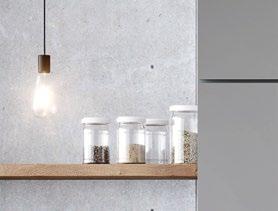
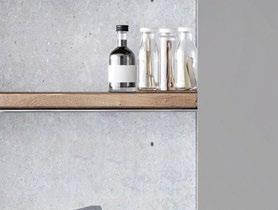
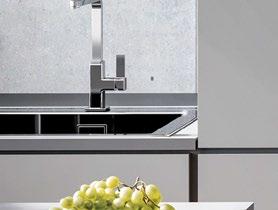












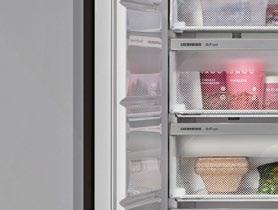
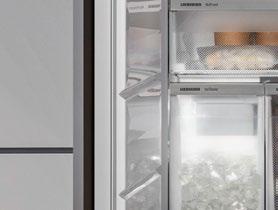











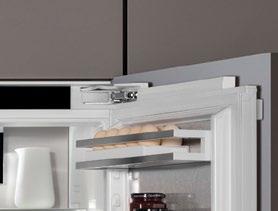










IN SOUTH AFRICA, COFFEE IS NO LONGER JUST A MORNING RITUAL — IT’S A LIFESTYLE, A CULTURE, AND IN MANY SPACES, AN ART FORM. FROM TOWNSHIP CAFÉS TO BOUTIQUE HOTEL LOUNGES, CONSUMERS ARE DEMANDING MORE THAN JUST CAFFEINE; THEY’RE CHASING QUALITY, ORIGIN STORIES, AND A SENSORY EXPERIENCE IN EVERY CUP.
Crafting a truly remarkable brew starts long before the espresso shot hits the cup.
For roasters and hospitality professionals, this shift is a golden opportunity — but also a serious responsibility. Crafting a truly remarkable brew starts long before the espresso shot hits the cup. It begins at the source, is honed in the roastery, and is perfected at the bar.
Here’s a roaster’s guide to brewing better — not just coffee, but connection.
Great coffee begins at the farm. Whether you’re sourcing single-origin beans from Ethiopia, Brazil, Kenya, or closer to home in South Africa’s own Limpopo and Mpumalanga regions, understanding the origin is critical.
• Altitude matters: Higher elevation beans tend to offer brighter, more complex flavours.
• Processing method: Washed, natural, or honeyprocessed beans all bring distinct taste notes to the cup.
• Traceability: Modern coffee lovers want to know not just where the bean came from, but who grew it. For roasters and hospitality buyers, working directly with farmers or reputable importers who prioritise ethical sourcing is a step toward transparency and impact.
Roasting is where the bean’s potential becomes a reality. It’s part chemistry, part instinct — and all about consistency.
• Light roasts highlight floral and fruity notes — perfect for pour-overs and connoisseurs.
• Medium roasts offer balance and body — ideal for cafes looking to serve a broad clientele.
• Dark roasts bring out bold, smoky flavours —
popular for milk-based drinks like cappuccinos. Smart roasters profile their beans with precision, using software and roasting logs to capture temperature curves and tweak flavour over time. The goal? Consistency across every batch and every cup.
The same bean can taste dramatically different depending on how it’s brewed. Cafés and hotel restaurants should consider offering a few manual brew options alongside the usual espresso lineup.
• Espresso: Fast, strong, and the base of every latte and flat white.
• French Press: Rich and full-bodied; perfect for breakfast service.
• Pour-Over: Clean and bright; a favourite among specialty enthusiasts.
• Cold Brew: Smooth and refreshing; ideal for hot summer months.
Training baristas to understand the nuances of grind size, water temperature, and brew time ensures the full potential of your beans is honoured.
Baristas are the bridge between the roaster and the consumer. Their skill and knowledge can make or break a coffee experience.
Invest in regular training that covers:
• Extraction techniques
• Milk texturing and latte art
• Origin education
• Customer engagement
In 2026, guests don’t just want a cup of coffee — they want a conversation, a recommendation, a reason to come back. Empower your staff to tell the story behind the beans.
In an Instagram-driven age, your coffee must look as good as it tastes. But more than that, small design details reflect your brand’s attention to quality.
• Serve in ceramic or branded cups
• Use sustainable, biodegradable takeaway packaging
• Offer custom sleeves that tell the bean’s origin or your café’s story
• Highlight brew notes on table menus
These touches elevate perception — and justify premium pricing.

Take your coffee program to the next level by offering food pairings that complement the brew. Think:
• Citrus-toned Kenyan filter with a lemon tart
• Bold Brazilian espresso with dark chocolate brownies
• Light Ethiopian roast with almond croissants
This enhances the experience and opens new upsell opportunities for cafés, hotels, and restaurants.
Conscious consumers are asking: Is my cup of coffee doing good?
• Partner with ethical growers
• Use compostable pods or packaging
• Reduce water waste in preparation
• Offer discounts for customers with reusable cups
• Share your sustainability journey on social platforms
Being eco-conscious is no longer a niche trend — it’s expected.

In 2026, building a better brew isn’t just about what’s in the cup — it’s about experience, ethics, education, and elevating expectations.
Whether you’re a hotel group curating an in-room coffee menu or a roaster scaling up for retail and wholesale, the opportunity is rich and aromatic. The key is to think beyond the bean — and deliver a coffee culture that’s authentic, informed, and unforgettable.
Because in the world of modern hospitality, great coffee doesn’t just start the day. It starts a relationship. TT



IN THE EVER-DEMANDING WORLD OF PROFESSIONAL KITCHENS, EFFICIENCY, PRECISION, AND INNOVATION AREN’T JUST HELPFUL — THEY’RE CRITICAL. AS WE NAVIGATE 2026, THE EVOLUTION OF KITCHEN TOOLS IS TRANSFORMING HOW CHEFS WORK, HOW KITCHENS ARE RUN, AND HOW FOOD IS ULTIMATELY EXPERIENCED.
Whether you’re upgrading your restaurant’s back of house or looking for competitive edge in a hotel kitchen, these 10 gamechanging tools deserve a place in your arsenal.
1SMART COMBI OVENS
Why it’s a game changer:
These multi-functional ovens now come equipped with AI learning, cloud connectivity, and humidity sensors. They can remember cooking cycles, adjust temperatures on the fly, and even notify you when your roast is perfectly done.
Best for:
High-volume kitchens needing versatility and consistency.
2PRECISION INDUCTION COOKTOPS
Why it’s a game changer:
Fast, safe, and ultra-efficient, modern induction systems offer pinpoint temperature control, reducing energy waste and improving cooking times — ideal for open kitchens or food trucks.
Best for:
Chefs who need speed without sacrificing control or safety.
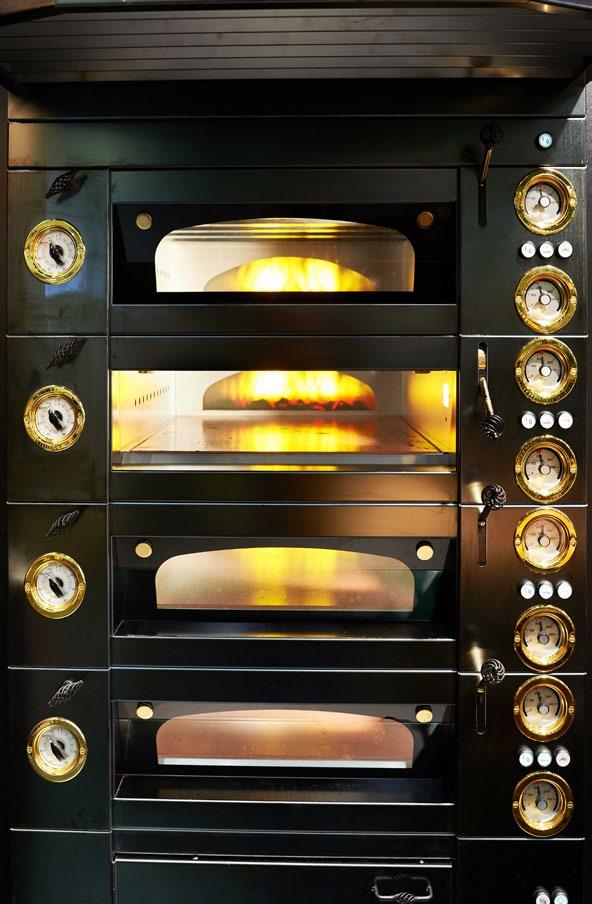
Blending under vacuum preserves colour, nutrients, and flavour. Your sauces, soups, and smoothies have better texture and shelf life...
Why it’s a game changer:
Say goodbye to repetitive prep work. These robotic units can chop, dice, julienne, and portion with minimal input — improving speed, safety, and portion control, especially during peak service.
Best for:
Restaurants with high turnover or limited prep staff.
Why it’s a game changer:
Blending under vacuum preserves colour, nutrients, and flavour. Your sauces, soups, and smoothies have better texture and shelf life — perfect for modern fine dining and wellness menus.
Best for:
Health-focused kitchens or beverage bars.
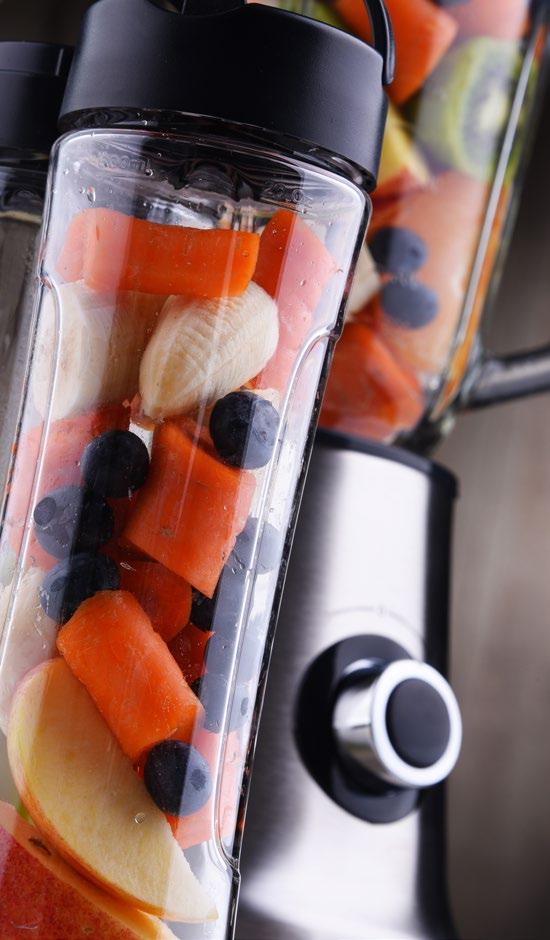
Why it’s a game changer:
These scales don’t just measure — they sync with your kitchen inventory system, updating stock in real-time, helping to reduce waste and improve ordering accuracy.

Best for:
Hotels, caterers, and cloud kitchens managing tight margins.
Why it’s a game changer:
More than just power tools, these blenders can heat, emulsify, and purée in seconds. They’re now quieter and more compact — ideal for mise en place, sauces, or silky smooth purees on the go.
Best for:
Boutique kitchens and chefs who prize texture and speed.
7
SOUS-VIDE SMART CIRCULATORS
Why it’s a game changer:
Precise sous-vide cooking is no longer reserved for fine dining. These newer models are compact, appcontrolled, and compatible with larger batch systems — giving chefs ultimate control over temperature and timing.
Best for:
Consistent protein prep, delicate desserts, or prepahead solutions.
8
TOUCHLESS DISPENSERS AND SANITISING SYSTEMS
Why it’s a game changer:
Hygiene meets convenience. From soap and sanitiser stations to oil and ingredient dispensers, touchless tech is improving safety and speed — especially postpandemic.
Best for:
Every kitchen prioritising food safety and HACCP compliance.
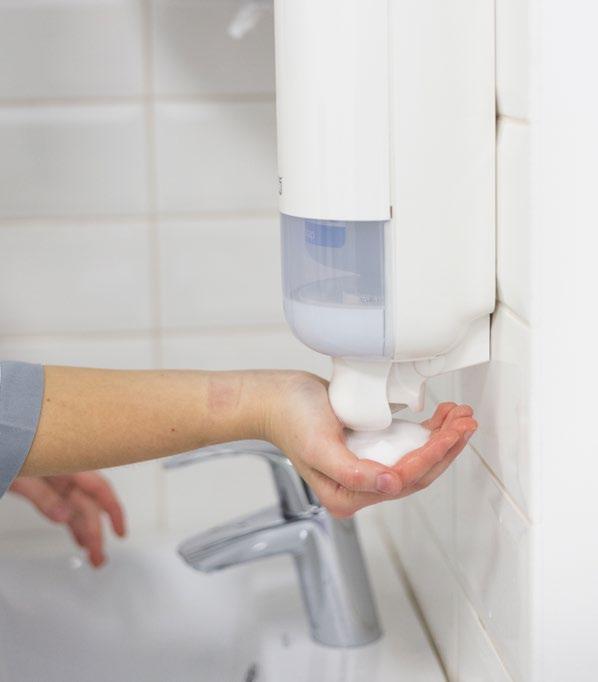

9 MODULAR COLD STORAGE SYSTEMS
Why it’s a game changer:
These mobile, energy-efficient units allow custom layouts, better air circulation, and even smart temperature monitoring. Some even alert your phone when temps rise.
Best for:
Kitchens with changing needs or limited space.
10
AI-DRIVEN KITCHEN MANAGEMENT PLATFORMS
Why it’s a game changer:
These software systems monitor prep times, food waste, energy usage, and staff performance — helping managers make real-time decisions backed by data.
Best for:
Group restaurants, franchises, and high-pressure operations.
THE BOTTOM LINE: EQUIP TO EXCEL
As margins tighten and expectations rise, the right tools can mean the difference between chaos and control. In 2026, smart investment in kitchen technology is about more than flash — it’s about functionality, staff wellbeing, and long-term savings.
Whether you’re running a bustling gastropub, a boutique lodge, or a fast-growing food chain, these game-changing tools offer more than convenience — they offer competitive edge.
So, is your kitchen ready for the future? TT

Blend smarter with the nutribullet® Smart Touch Blender™ .
This sleek and powerful machine operates via touchscreen display, with four precision programs, three speeds, and a pulse function that take the guesswork out of blending.
It’s also equipped with a 1500-Watt motor and high-capacity 1.9L pitcher to smooth even the toughest ingredients.
Streamlined functionality with optimal results — now that’s clever.

IN THE HOSPITALITY AND FOOD SERVICES INDUSTRY, FRESHNESS IS EVERYTHING — NOT JUST FOR TASTE, BUT FOR TRUST. WHETHER YOU’RE STORING SALMON SASHIMI IN A SUSHI BAR OR PREPPING CREAM-FILLED PASTRIES IN A HOTEL KITCHEN, MAINTAINING SAFE, REGULATED TEMPERATURES IS THE SILENT GUARDIAN OF QUALITY.
Yet in 2026, refrigeration is no longer just a backof-house utility.
It’s a strategic asset. In a world shaped by climate change, rising energy costs, and increasingly savvy consumers, cold chain management is moving to the front line of operational excellence.
So, what exactly is the cold chain, and why does it matter now more than ever? WHAT IS THE COLD CHAIN?
The cold chain refers to a temperature-controlled supply system that spans from production to storage to service. It includes:
• Chillers and cold rooms
• Refrigerated transport
• Display fridges and service units
• Temperature monitoring systems Every break in the chain — whether during delivery, unloading, or internal storage — can result in spoiled goods, financial losses, and serious
food safety risks. WHY IT’S BECOMING A PRIORITY IN 2026
1. Food Safety Regulations Are Tightening
With increasing pressure from health departments and industry regulators, there’s no room for guesswork. Temperaturesensitive items like dairy, meat, seafood, and fresh produce must be stored and served within precise parameters. Smart kitchens are now
integrating real-time temperature tracking and automated alerts to avoid violations and keep records for audits.
2. Load Shedding & Energy
Insecurity in SA
Unreliable electricity has forced the industry to rethink refrigeration systems. Losing power for even an hour can push perishable stock past the safety zone.
The result? A growing demand for:
- Energy-efficient cold rooms
- Refrigeration units with battery backup
- Solar-integrated systems
- Cloud-based monitoring that alerts staff when fridges are offline
Forward-thinking establishments are now investing in cold chain continuity plans alongside their emergency lighting and POS systems.
3. Consumer Expectations Around Freshness
Today’s diners are more informed than ever. They ask where their food comes from — and how it’s been handled.
A bruised berry or sour cream can be enough to damage your brand’s credibility. More chefs are showcasing “cold chain care” as part of their food story — especially in fine dining and health-focused concepts.
4. Waste Reduction = Cost Savings
Improper storage leads to food waste. And food
waste leads to lost profits. With tighter margins and rising food costs, smart refrigeration isn’t just a safety requirement — it’s a cost-saving strategy.
Modern cold storage systems help:
• Track expiry dates and stock rotation
• Keep ingredients fresh
for longer
• Prevent overstocking and spoilage
• Alert staff when temperatures rise above safe limits
The result is leaner inventory and tighter controls — essential in today’s unpredictable economic climate.
SMART SENSORS & IOT INTEGRATION
Refrigerators now come with sensors that send real-time data to a mobile dashboard. Alerts are triggered when doors are left open or temps rise too high — even during delivery.
SOLAR-POWERED COLD UNITS
With energy insecurity a daily concern, brands are investing in cold storage powered by rooftop solar or hybrid systems.
MOBILE COLD ROOMS FOR EVENTS & POP-UPS
As mobile dining and event catering expand, cold storage is going on the move — with temperature-controlled trailers and mobile walk-ins keeping products safe in remote locations.
DIGITAL COLD CHAIN LOGBOOKS
Manual logs are out. App-based recordkeeping for cold storage is becoming standard practice, especially for franchises and HACCPcertified kitchens.
WHO’S RESPONSIBLE? EVERYONE.
From delivery drivers and receiving clerks to kitchen managers and front-of-house staff, the cold chain relies on everyone understanding their role.
• Suppliers must transport goods in refrigerated vehicles.
• Staff must inspect deliveries with thermometers — not just trust the invoice.
• Storage must be organised with FIFO (First In, First Out) principles.
• Training must reinforce cold chain standards at every touchpoint.
In a climate where one spoiled batch can cost thousands — or damage your brand — cold chain management has become one of the most powerful operational tools in hospitality.
In 2026, refrigeration isn’t just about keeping things cold. It’s about keeping your promise of quality, your profit margins stable, and your customers safe.
A reliable cold chain isn’t a luxury. It’s your frontline defense — and a signal that your establishment takes excellence seriously. TT


ONCE THE SYMBOL OF INDULGENT HOTEL LIVING — A SILVER TRAY WITH A DOMED LID, WHEELED QUIETLY TO A GUEST’S DOOR — ROOM SERVICE IS FACING A RENAISSANCE. IN A WORLD SHAPED BY MOBILE-FIRST HABITS, GLOBAL FOOD DELIVERY APPS, AND A DESIRE FOR PERSONALISATION, THE CLASSIC ROOM SERVICE MODEL IS OVERDUE FOR A FRESH APPROACH.

As we move through 2026, forward-thinking hotels aren’t ditching room service — they’re reinventing it. The result? Faster, smarter, more guest-centric offerings that combine comfort with convenience.
Traditional room service has long been plagued by slow wait times, clunky menus, cold food, and high operational costs. In many cases, guests opt out entirely — either due to lack of appeal or the rise of external delivery platforms like Uber Eats.
And yet, the demand for in-room dining hasn’t disappeared. Guests still want the comfort of eating in their room — just on their terms.
• Post-pandemic habits: Guests are more hygiene-conscious and privacy-focused. Contactless service is no longer a luxury — it’s expected.
• Tech-savvy travellers: With everything from check-in to lighting now app-controlled, guests expect room service to be just as seamless.
• Food delivery culture: Guests are used to tracking their meals, customising orders, and browsing dynamic menus from their phones.
• Operational pressure: Hotels need revenue-generating services that don’t strain staff or require full kitchens operating round the clock.
The dusty in-room menu binder is obsolete. Replace it with a QR code or in-room tablet that links to a dynamic digital menu. Update offerings

seasonally, adjust pricing during peak periods, and showcase local specials or chef-curated experiences.
Bonus: Guests can order with a tap — no calls, no waiting on hold.
2.
Instead of running a full-service kitchen 24/7, many hotels are partnering with trusted local food businesses to offer curated in-room delivery menus. You keep control of quality and guest experience — while expanding culinary options and reducing cost.
Think of it as a concierge-led takeout service with a hospitality touch.
Contactless delivery doesn’t mean impersonal. Whether food is dropped at the door in stylish, heat-retaining packaging or handed off with a smile and minimal contact, presentation still matters. Branded bags, handwritten notes, or complimentary snacks can
elevate the moment.
Modern guests want to know when their order is arriving. Use mobile tracking or SMS alerts to provide updates, just like food delivery apps do. Consider adding “express options” that guarantee delivery within 15 minutes for select items — ideal for business travellers.
Room service menus should reflect how people really eat in private:
• Soul food classics (mac and cheese, sliders, curry bowls)
• Breakfast all day
• Light, healthy options for wellness travellers
• Indulgent midnight snacks (hello, chocolate fondant and milk)
Consider curated combos: movienight boxes, romantic dinner kits, or hangover recovery packs.

Modern room service extends beyond meals. Upsell by including:
• Beverage menus (cocktails, wine, artisanal sodas)
• Spa kits or aromatherapy add-ons
• Dessert carts or coffee trays for late-night cravings
• Tech rentals, charging kits, or wellness gadgets
These extras not only delight guests — they boost revenue per stay.
This boutique property replaced its traditional room service with a curated local experience. Guests now scan a QR code to browse dishes from three partner restaurants within walking distance. Orders are delivered within 30 minutes, beautifully packaged with
hotel branding.
The result? A 60% increase in in-room dining usage and rave reviews for offering “a taste of the city without leaving your slippers.”
The best modern room service isn’t about silver platters or tuxedoed staff. It’s about convenience, connection, and comfort. It reflects the personality of your hotel, meets the lifestyle of your guests, and makes staying in feel like a treat.
As hospitality evolves, so must the experiences we offer behind closed doors. Rethink the tray, reinvent the moment — and rediscover the power of a meal served in-room. TT
The best modern room service isn’t about silver platters or tuxedoed staff. It’s about convenience, connection, and comfort.


IN 2026, GREAT FOOD ALONE IS NO LONGER ENOUGH TO GUARANTEE A GREAT RESTAURANT EXPERIENCE. TODAY’S DINERS AREN’T JUST EATING — THEY’RE ABSORBING, REACTING, SHARING, AND JUDGING EVERYTHING FROM THE MENU FONT TO THE BATHROOM LIGHTING. AND WHETHER THEY REALISE IT OR NOT, HOW THEY FEEL INSIDE YOUR SPACE AFFECTS HOW THEY PERCEIVE YOUR FOOD, YOUR SERVICE — AND WHETHER THEY’LL RETURN.
Welcome to the world of restaurant psychology, where design meets behaviour, and every surface, colour, and sound has a purpose.
WHY DESIGN AFFECTS DINING
People eat with their eyes — not just on the plate, but in the room. The human brain is wired to respond to visual, spatial, and sensory cues that signal safety, comfort, pleasure, or excitement.
Restaurant design, when done right, taps into these primal responses to:
• Enhance appetite
• Influence dining speed
• Increase perceived value
• Encourage social interaction
• Shape emotional memory
A beautiful dish served in a poorly lit, noisy, or uncomfortable space loses its magic. But a good meal in a well-designed room can become unforgettable.
1. COLOUR: APPETITE’S SECRET INGREDIENT
Colour plays a surprisingly powerful role in shaping mood and behaviour — especially when it comes to food.
Warm tones (red, orange, terracotta):
These stimulate appetite and create a sense of energy. They’re ideal for fast-paced, high-turnover restaurants.
Earthy neutrals (beige, taupe, olive):
These create a calm, grounded feeling — perfect for fine dining and longer experiences.
Cool tones (blue, grey):
Often suppress appetite slightly, but can evoke sophistication and cleanliness in seafood or minimalist venues.
Pro Tip: Accent walls, tableware, or upholstery in specific colours can subtly direct the vibe without overwhelming the senses.
Lighting sets the emotional tone of a restaurant before a word is spoken or a bite is taken.
• Bright, natural lighting energises lunch crowds and appeals to wellness-conscious diners.
• Dim, warm lighting slows guests down, makes food look richer, and encourages lingering — perfect for romantic or highend venues.
• Accent lighting on artwork, bottles, or plating zones adds depth and drama.
Avoid harsh overhead fluorescents or inconsistent lighting levels that confuse the eye and flatten the mood.
Noise is one of the top complaints in otherwise successful restaurants. Yet the right soundscape can amplify mood and even influence what people order.
• Soft background music can improve digestion and encourage longer stays.
• High-energy playlists can stimulate turnover during peak hours.
• Sound-absorbing materials like curtains, upholstery, and acoustic panels reduce echo and improve conversation clarity.
Even the clink of cutlery or hum of an espresso machine can add to — or detract from — the atmosphere.

Space planning is more than fitting tables into a room — it’s about controlling flow, privacy, and service efficiency.
• Open layouts with communal seating encourage social interaction and work well for casual, modern eateries.
• Zoned areas with varied seating (booths, banquettes, high tops) cater to different moods and group sizes.
• Sightlines matter: Guests shouldn’t stare into the kitchen garbage or bathroom hallway while they eat.
Don’t forget the staff journey — well-designed layouts reduce server fatigue, improve service speed, and limit awkward guest interactions.
Texture isn’t just visual — it’s tactile and emotional. The materials guests touch influence their perception of quality.
• Wood and stone evoke authenticity and warmth
• Marble and brass signal luxury and refinement
• Raw concrete or metal give off an edgy, urban feel
Combining soft (velvet, leather, linen) and hard (ceramic, steel, glass) textures adds contrast and complexity — much like a great menu.

People remember how a space made them feel. Design is your firstand lastingimpression.
From the door handle to the restroom mirror, every design choice tells your brand story.
• Custom napkins, coasters, or chairs reinforce identity
• Signage and menus should match the design tone — minimalist, vintage, Afro-chic, or retro
• Instagram moments (neon quotes, tile patterns, scenic corners) turn guests into your marketers
People remember how a space made them feel. Design is your first — and lasting — impression.
In today’s competitive hospitality world, design is no longer just about beauty — it’s about behaviour. When your space is built with intention, every guest interaction — from the way they’re seated to the way they snap a photo — becomes part of a curated experience.
The psychology of interiors isn’t about manipulation — it’s about mindful design that aligns your space with your brand and your guests’ unspoken needs.
After all, great hospitality doesn’t just happen on the plate. It happens in the room. TT


















































































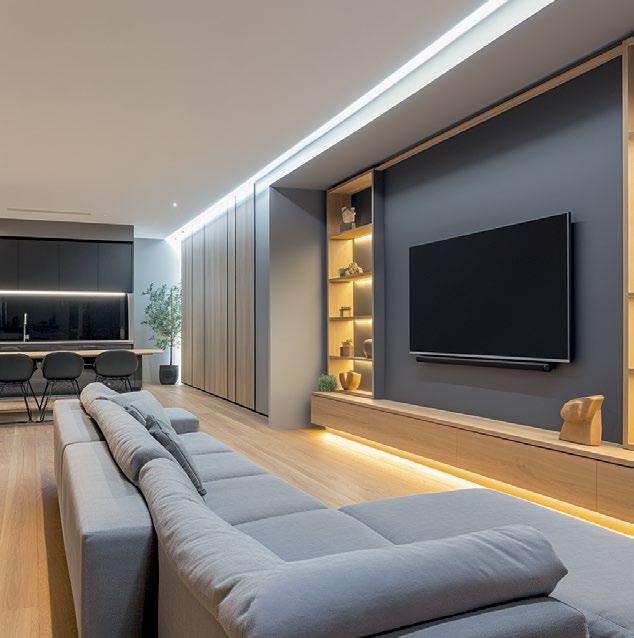















and Choking emergencies can happen to anyone, anywhere, anytime!

HIGH QUALITY BAGS
Bags for emergencies, nursing, medicine, and first aid.
DEFIBRILLATOR FOR SCA
Early defibrillation is crucial for survival during cardiac arrest. Philips AEDs are trusted, safe and easy to use.




ALL FIRST AID EQUIPMENT
First aid cabinets,
CHOKING RESCUE DEVICE
In a choking emergency getting an obstruction out is essential.

Optimal CPR compressions and rates are vital.
Ventria offers connected, and managed, all-in-one carefree services designed to give you confidence that your staff are ready for any emergency.

DEFIBRILLATOR FOR SCA
Quality CPR and defibrillation are crucial for survival during cardiac arrest. Zoll AEDs provides CPR feedback, ensuring the responder is getting the correct compression.
We provide all products to assist first responders in an emergency, including first aid kits and rescue packs